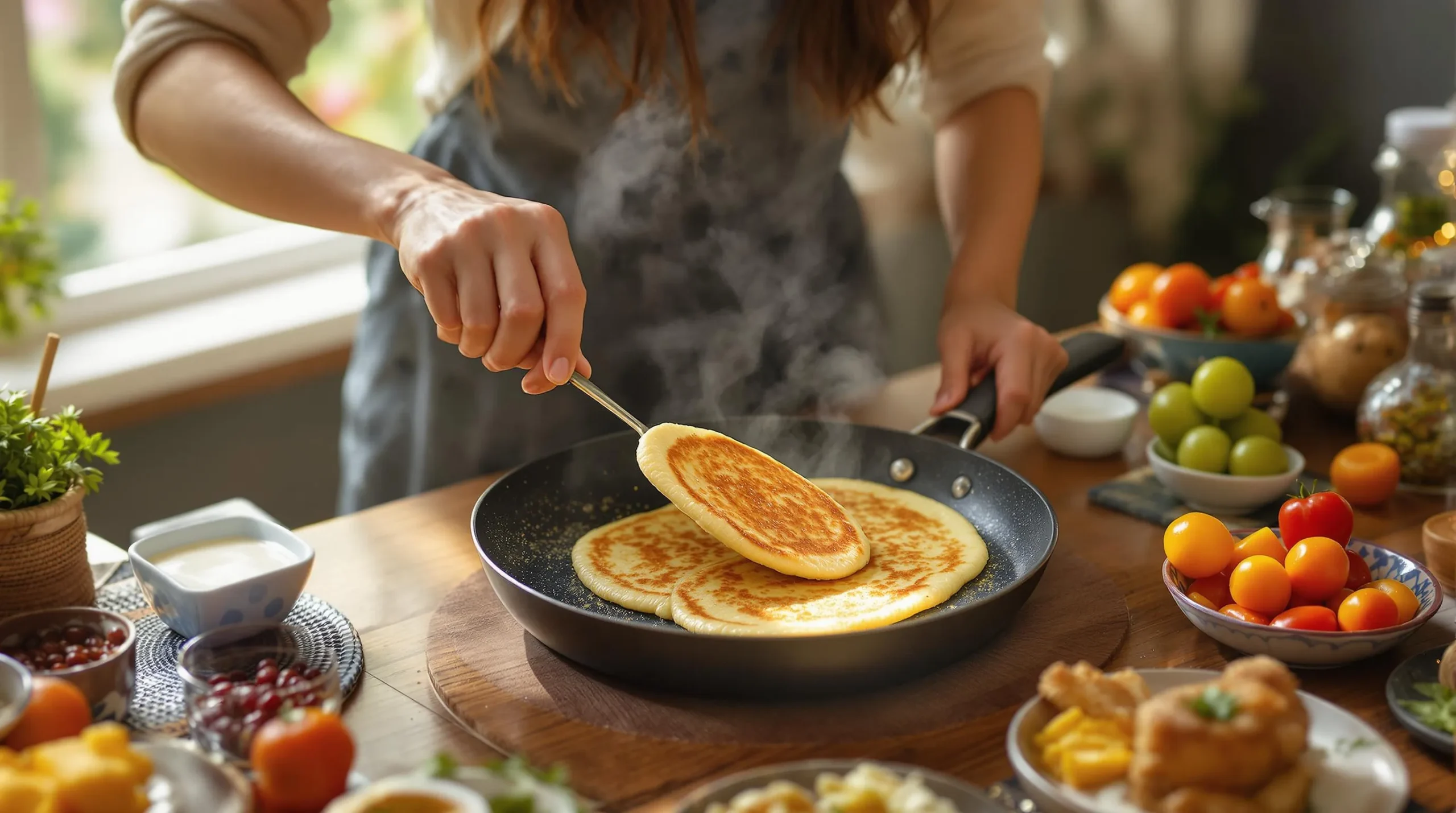What Are Blini: Traditional Russian Crepes
Blini are thin Russian pancakes similar to French crepes but with distinctive characteristics that make them uniquely Russian. These delicate discs have been a cornerstone of Russian cuisine for centuries dating back to pre-Christian times when they symbolized the sun during pagan celebrations.
Traditional blini are made from yeasted batter which creates their signature slightly tangy flavor and airy texture. The authentic version uses buckwheat flour though modern variations often incorporate wheat flour for a lighter result. Their diameter typically ranges from 7-9 inches making them larger than American pancakes but similar in size to French crepes.
Russians serve blini with an impressive array of toppings and fillings. Savory options include sour cream caviar smoked salmon or herring while sweet variations might feature honey jam or sweetened condensed milk. During Maslenitsa the week-long celebration before Lent blini consumption reaches its peak as families gather to enjoy these golden treats.
Unlike thicker American-style pancakes blini should be paper-thin with a delicate lacy pattern from proper cooking. The texture strikes a perfect balance between softness and slight chewiness with tiny air bubbles throughout from the fermentation process. A properly made blini can be folded without breaking making it ideal for wrapping around various fillings.
What truly sets blini apart is their cultural significance in Russian traditions. They’re not just food but rather a symbol of hospitality generosity and the changing seasons. When you make blini you’re participating in a culinary tradition that has united generations of Russians through celebrations hardships and everyday meals alike.
Why You’ll Love This Authentic Blini Recipe
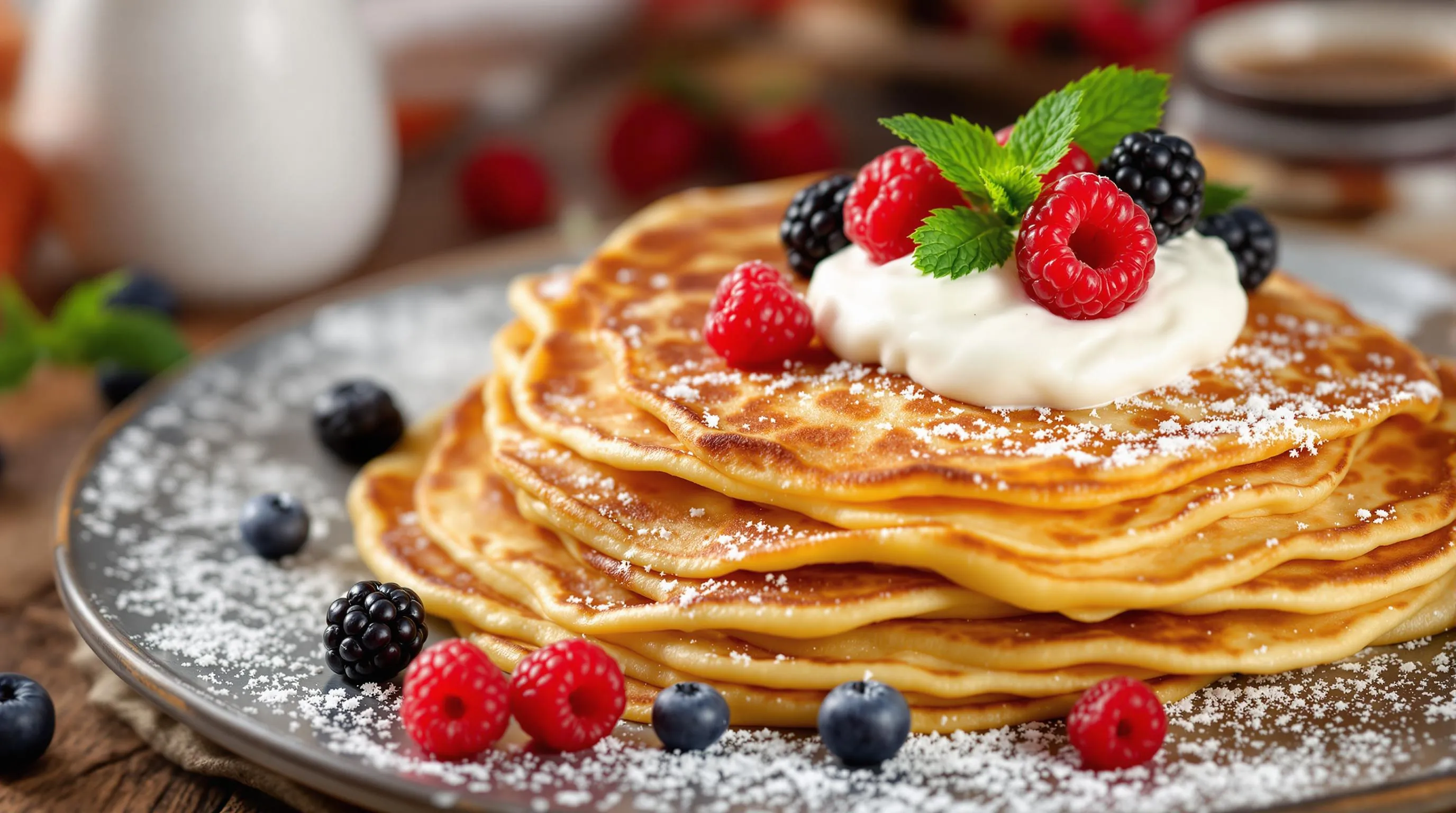
These traditional Russian crepes will quickly become a staple in your home cooking repertoire for many compelling reasons:
- Perfect Texture: The yeast in this authentic recipe creates that distinctive airy texture with delicate bubbles throughout each blini.
- Versatile Serving Options: Enjoy these thin pancakes with both sweet and savory toppings—from smoked salmon and caviar to honey and fresh berries.
- Make-Ahead Friendly: The batter benefits from resting time which fits perfectly into busy schedules.
- Simple Ingredients: You likely have most ingredients already in your pantry making this an accessible recipe.
- Cultural Experience: By preparing these blini you’re participating in a centuries-old Russian tradition that has connected generations.
- Crowd-Pleaser: These delicate crepes impress guests at brunches gatherings or special celebrations.
- Adaptable Recipe: While maintaining authenticity this recipe allows for adaptations based on dietary preferences including gluten-free options.
- Beginner-Friendly: Even though their impressive appearance the step-by-step instructions make this recipe approachable even for novice cooks.
- Distinctive Flavor: The slight tanginess from the fermentation process gives these blini a depth of flavor that distinguishes them from regular pancakes.
The traditional technique used in this recipe ensures you’ll achieve that signature soft pillowy texture that sets authentic Russian blini apart from other crepe variations around the industry.
Equipment Needed
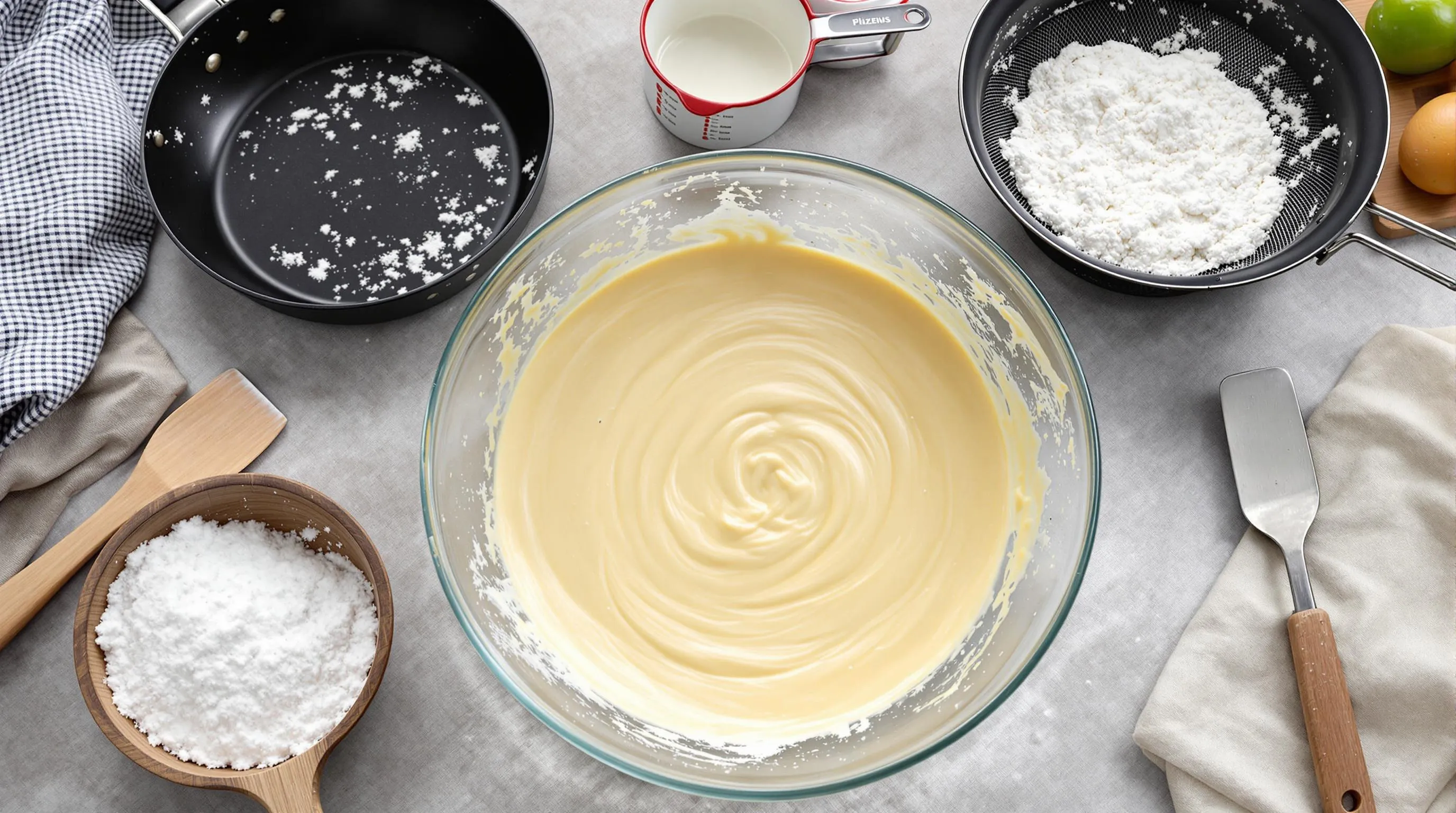
Making authentic Russian blini requires minimal equipment but having the right tools will ensure your crepes turn out perfectly thin and evenly cooked. Here’s what you’ll need to prepare these traditional Russian pancakes:
- Large mixing bowl – For combining ingredients and allowing the batter to rise properly
- Whisk – Essential for creating a smooth, lump-free batter
- Measuring cups and spoons – For accurate ingredient measurements
- Sieve or strainer – To ensure your flour is free of lumps
- Ladle or 1/4 cup measure – For consistent portioning of batter onto the pan
- Non-stick skillet or crepe pan – Preferably 8-10 inches in diameter for traditional-sized blini
- Spatula – A thin, flexible spatula works best for flipping delicate crepes
- Plate or platter – For stacking finished blini
- Kitchen towel – To cover and keep your blini warm while cooking the remaining batter
- Optional: thermometer – To check that your milk is at the right temperature for activating yeast
Your non-stick skillet or dedicated crepe pan plays the most crucial role in this recipe. The flat surface allows the batter to spread evenly while the non-stick coating helps prevent tearing when flipping. Many Russian households pass down well-seasoned cast iron pans specifically used for blini making, but any good quality non-stick pan will work perfectly for beginners.
Ingredients For Russian Blini
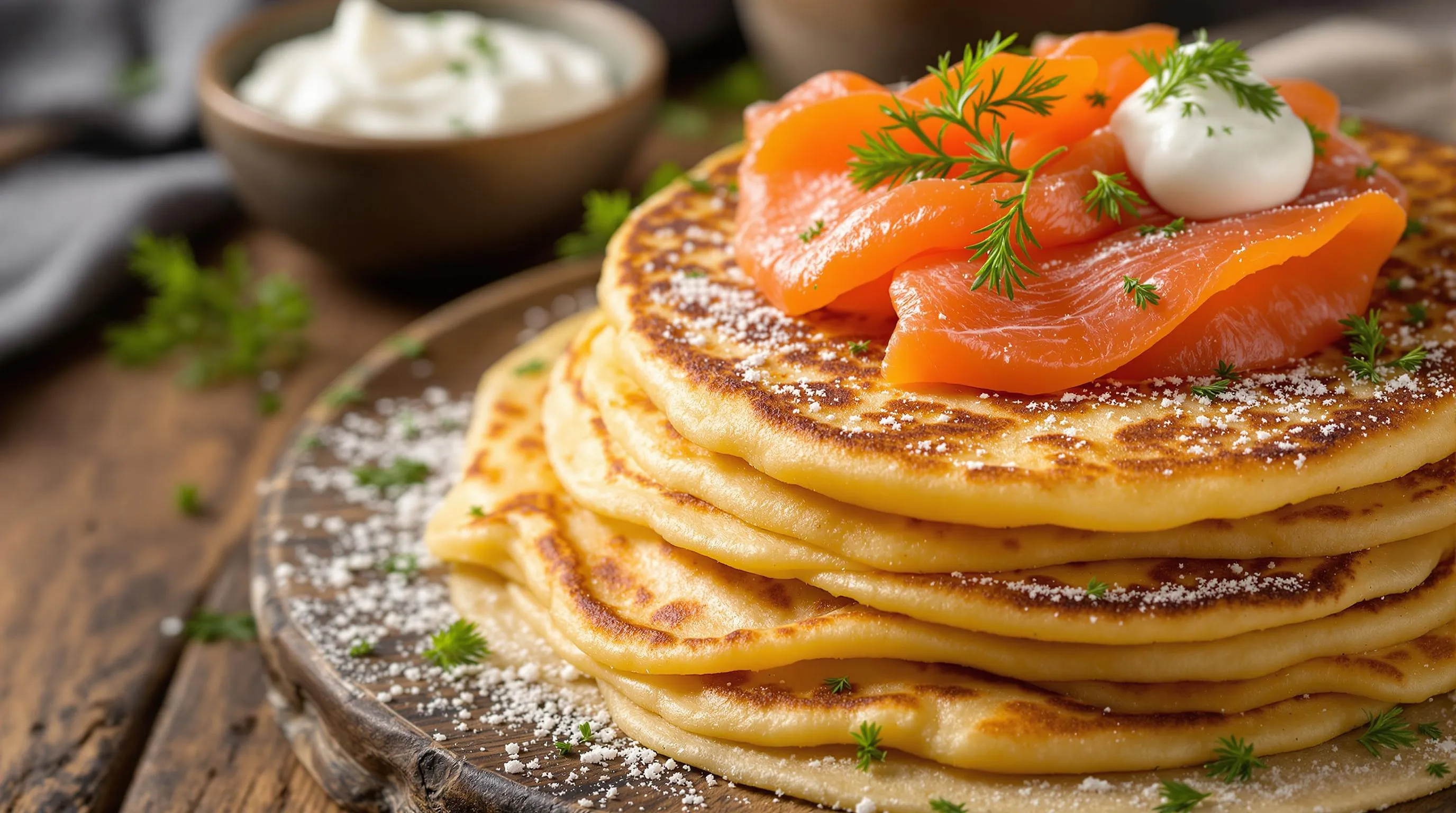
Creating authentic Russian blini requires simple pantry staples that combine to create light yet flavorful crepes. The following ingredients will yield approximately 15-20 blini depending on the size of your pan.
For The Batter
- 2 cups all-purpose flour
- 1 cup buckwheat flour (for traditional blini) or substitute with all-purpose flour
- 2½ cups warm milk (105-110°F)
- ½ cup warm water
- 2 tablespoons active dry yeast
- 2 tablespoons sugar
- 3 large eggs at room temperature
- 2 tablespoons melted butter plus extra for cooking
- 1 teaspoon salt
- ½ teaspoon baking soda (added just before cooking)
For Serving
- Sour cream (smetana)
- Butter for spreading
- Smoked salmon
- Red caviar (ikra)
- Thinly sliced green onions
- Fresh dill sprigs
- Honey or maple syrup for sweet variations
- Fruit preserves or jam
- Fresh berries (strawberries, blueberries, raspberries)
- Sweetened condensed milk
- Chopped nuts like walnuts or hazelnuts
- Lemon wedges (especially when serving with savory toppings)
How To Make Russian Blini

Creating authentic Russian blini requires patience and attention to detail. The process involves three main stages: preparing the batter preparing it properly letting it ferment and cooking the crepes with the right technique.
Preparing The Batter
Start by warming your milk to about 110°F (43°C) – it should feel warm to the touch but not hot. In a large mixing bowl dissolve the active dry yeast and sugar in the warm milk then let it stand for 5-10 minutes until foamy. This activation step ensures your blini will have that characteristic light and airy texture.
Sift both the all-purpose and buckwheat flours together to remove any lumps. Gradually add the flour mixture to your yeast mixture stirring continuously to prevent clumps from forming. The batter should be relatively thin at this stage.
Beat your eggs in a separate bowl then incorporate them into the batter along with the salt. Add the melted butter and mix thoroughly until smooth. Cover the bowl with a clean kitchen towel and place it in a warm spot to ferment for at least 1 hour but ideally 2-3 hours. For the best flavor development you can even let it rest overnight in the refrigerator.
Right before cooking stir in the baking soda dissolved in a tablespoon of warm water. This final addition creates tiny air bubbles that contribute to the blini’s delicate texture. The batter should now have the consistency of heavy cream – fluid enough to spread easily in the pan but thick enough to coat the back of a spoon.
Cooking The Blini
Heat your non-stick skillet or crepe pan over medium heat. The pan is ready when a few drops of water sizzle on the surface. Lightly brush the pan with butter or oil before each blini.
Pour about 1/4 cup of batter into the center of the hot pan then immediately tilt and rotate the pan to spread the batter into a thin even circle approximately 7-9 inches in diameter. Work quickly as the batter starts setting almost immediately.
Cook until the edges look dry and tiny bubbles form on the surface about 1-2 minutes. The bottom should be golden brown. Flip the blini using a thin spatula and cook the other side for another 30-60 seconds until light golden spots appear.
Transfer the cooked blini to a plate and cover with a kitchen towel to keep warm. Stack them as you go adding a tiny bit of butter between each if desired. This stacking helps the blini stay soft and prevents them from drying out.
Tips For Perfect Blini
Maintain consistent temperature throughout the cooking process. Your pan should be hot enough to cook the blini properly but not so hot that they burn before cooking through. Medium heat typically works best.
The first blini often turns out imperfect – consider it your test pancake to adjust heat and batter consistency. Add a splash of milk if the batter seems too thick or a tablespoon of flour if it’s too thin.
Let your batter rest after mixing. The fermentation period is crucial for developing flavor and achieving the proper texture. Never skip this step even if you’re short on time.
Pour the batter from a height of about 4-5 inches above the pan to ensure it spreads evenly. Use a ladle with a spout for more precision and less splatter.
Flip the blini only once. Excessive flipping can make them tough rather than tender. Wait until the edges are set and the surface shows bubbles before attempting to turn them.
Keep your stack of finished blini covered with a kitchen towel and place them over a pot of warm water if needed to maintain their temperature while you finish cooking the entire batch.
Traditional Blini Toppings And Fillings

Blini achieve their full potential when paired with the right accompaniments. Russian tradition offers a wealth of both savory and sweet options that transform these delicate crepes into a complete culinary experience.
Savory Options
Russian blini excel as vehicles for savory toppings that range from simple to luxurious. Smoked salmon creates an elegant pairing that balances the crepe’s subtle tanginess with rich smoky notes. Red or black caviar (ikra) represents the ultimate traditional Russian topping—the tiny eggs pop delightfully against the soft texture of the blini. Sour cream (smetana) serves as both a topping and a binding agent for other ingredients; Russians typically spread it first before adding additional components.
Herring with diced onions offers a boldly flavored option that showcases Russia’s love of preserved fish. For a heartier preparation try mushroom filling sautéed with onions and herbs which provides an earthy complement to the blini’s yeasty profile. Farmers cheese (tvorog) mixed with herbs creates a protein-rich filling reminiscent of Russian cheese pancakes called syrniki.
Chopped hard-boiled eggs combined with green onions deliver a simple yet satisfying option for everyday meals. Smoked meats including ham or bacon appear frequently alongside blini especially during breakfast spreads. For a modern twist many Russians enjoy a savory crepe filled with ground meat (typically beef or pork) seasoned with dill and onions. Fresh herbs like dill chives and parsley frequently garnish savory blini adding bright flavor and visual appeal.
Sweet Options
Sweet blini toppings transform these versatile crepes into delectable desserts or breakfast treats. Honey represents perhaps the most traditional sweet accompaniment drizzled generously over warm blini where it melts slightly creating an irresistible golden coating. Fresh berries especially strawberries blueberries and raspberries provide a bright contrast to the slightly tangy blini. Fruit preserves (varenya) made from various berries cherries or apples offer concentrated fruit flavor with each spoonful.
Sweetened condensed milk holds special significance in Russian cuisine and creates a decadently sweet topping that slowly spreads across the warm surface. Apple sauce especially when homemade with cinnamon complements the slight fermentation notes in traditional blini. For chocolate enthusiasts Nutella or chocolate spread has become increasingly popular particularly among younger generations.
Sweetened farmers cheese mixed with vanilla and raisins creates a filling reminiscent of Russian cheese pastries. Sliced bananas with a dusting of powdered sugar offer a simple yet satisfying option that caramelizes slightly when placed on warm blini. Many Russians enjoy blini with poppy seed filling (mak) a traditional preparation that balances sweetness with the distinctive nutty flavor of the seeds. For special occasions try a luxurious combination of sweet cream butter and sugar which melts together creating a simple yet indulgent treat that showcases the blini’s delicate flavor.
How To Serve Blini The Russian Way
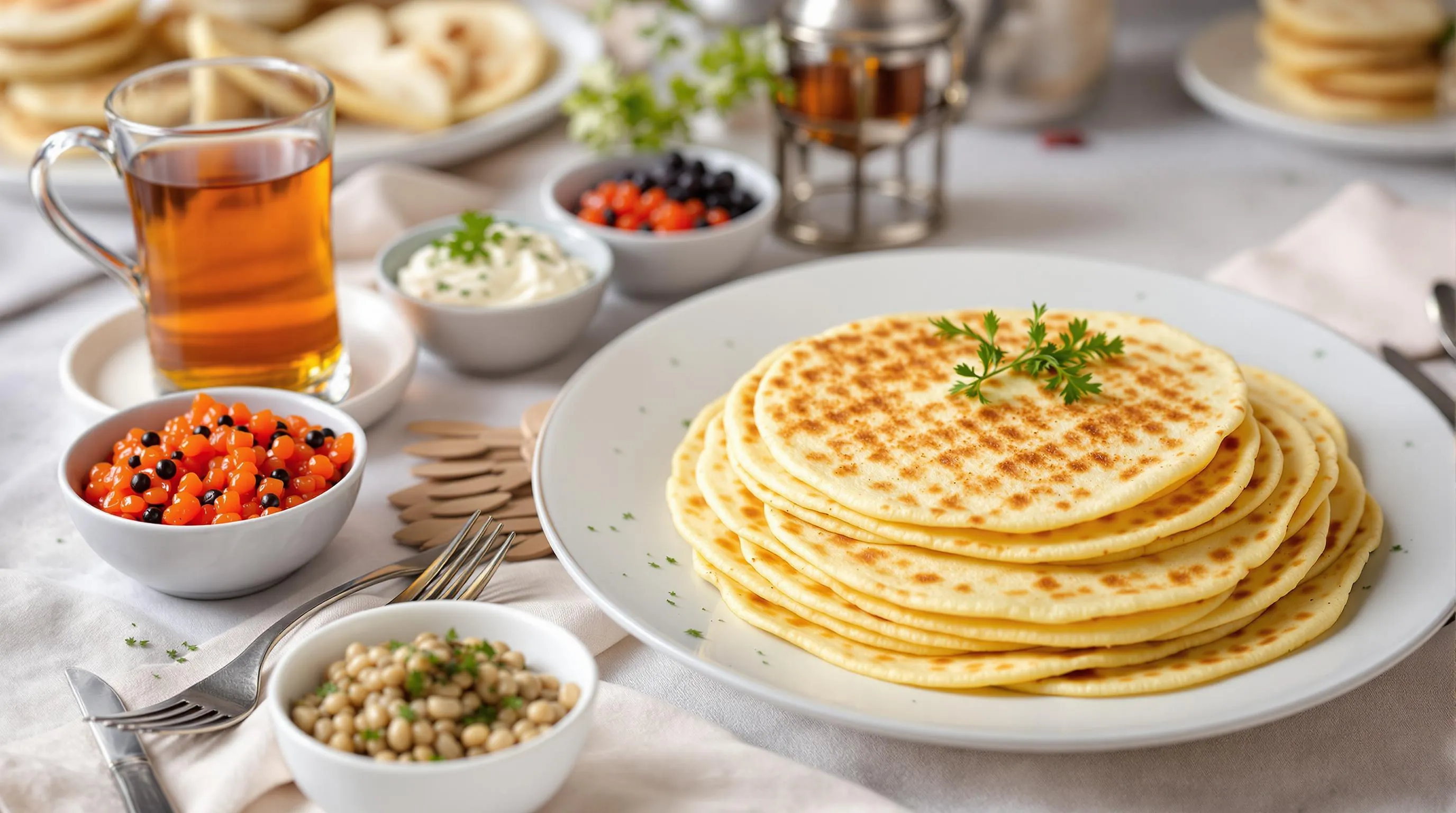
Russians have perfected the art of serving blini through centuries of tradition. Proper presentation transforms these simple crepes into a memorable culinary experience. Follow these authentic Russian serving customs to enjoy blini as they were meant to be savored.
Begin by arranging freshly made blini in a neat stack on a warmed plate. Russians traditionally cover the stack with a clean kitchen towel to keep them warm and soft while preparing the entire batch. For an authentic experience serve blini immediately after cooking rather than refrigerating and reheating them.
The classic Russian table setting for blini features small bowls of various toppings arranged around the central plate of crepes. This arrangement creates a beautiful presentation and allows guests to customize their blini according to personal preferences. Place sour cream (smetana) in a prominent position as it serves as the foundation for most blini combinations in Russian cuisine.
Savory toppings should be arranged thoughtfully with red and black caviar in small crystal or glass bowls accompanied by tiny spoons. Thinly sliced smoked salmon should be rolled and displayed on a separate plate. Chopped fresh herbs like dill and green onions typically appear in small dishes nearby to add brightness to the savory options.
For sweet servings present honey in a small bowl with a dedicated dipper. Arrange fruit preserves alongside sweetened condensed milk and fresh berries in separate containers. Russians often fold their blini into quarters or roll them into tubes after adding toppings rather than stacking multiple toppings on a flat crepe.
Traditional Russian hosting etiquette dictates that you should prepare the first blini for each guest according to their preference. This hospitable gesture demonstrates care and consideration for your visitors. Accompany the blini spread with hot tea served in glass cups with metal holders (podstakanniki) for an authentic Russian dining experience.
During Maslenitsa celebrations blini take center stage with even more elaborate presentations. Families often create towers of blini garnished with colorful toppings to symbolize the sun and welcome spring. For these festive occasions the table might feature carved butter pieces a variety of preserved fruits and special seasonal garnishes.
Storing And Reheating
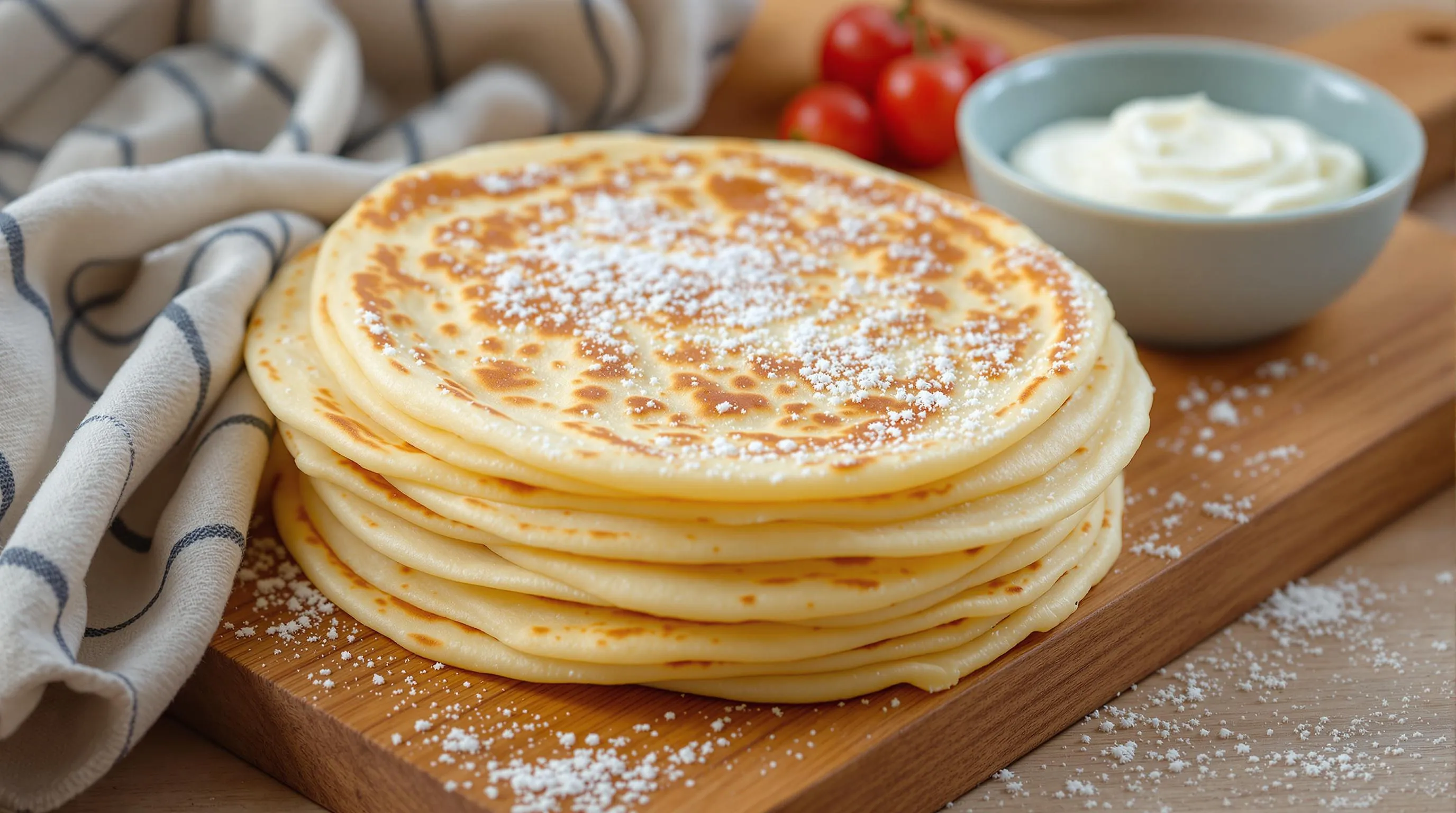
Proper storage techniques ensure your blini remain delicious even days after preparation. Freshly made blini stay good at room temperature for up to 6 hours when covered with a clean kitchen towel. For longer storage place completely cooled blini in an airtight container with parchment paper between each crepe to prevent sticking.
Refrigerated blini maintain their quality for 2-3 days. Simply stack them with sheets of parchment paper separating each layer and store in a sealed container. This method preserves their texture while preventing moisture buildup.
Freezing offers an excellent option for extending shelf life up to 2 months. Arrange cooled blini in single layers separated by parchment paper then wrap the stack tightly in plastic wrap before placing in a freezer-safe bag. Label the package with the date to track freshness.
When reheating refrigerated blini allow them to sit at room temperature for 15-20 minutes first. Heat a non-stick skillet over medium-low heat and warm each blini for about 30 seconds per side. Alternatively microwave stacks of 2-3 blini covered with a damp paper towel for 15-20 seconds.
For frozen blini thaw them in the refrigerator overnight before reheating using either method above. You can also reheat frozen blini directly in a 325°F (163°C) oven by wrapping the stack in foil and heating for 10-15 minutes until warmed through.
Traditional Russian households often reheat blini by steaming them. Place a colander over simmering water then arrange blini in the colander without overlapping. Cover with a lid and steam for 2-3 minutes until soft and warm.
Avoid reheating blini multiple times as this diminishes their delicate texture. Instead reheat only the portion you plan to consume immediately to maintain their authentic taste and pillowy consistency.
Make-Ahead Instructions

Blini are perfect for preparing in advance which makes them ideal for entertaining or busy weeknights. You can make the batter up to 24 hours before cooking by preparing it through the fermentation stage then storing it covered in the refrigerator. The cold temperature slows fermentation but allows flavors to develop more deeply creating an even tastier result.
For fully cooked blini you have several convenient options. Stack them with parchment paper between each crepe once they’ve completely cooled then wrap the stack tightly in plastic wrap. Store in the refrigerator for 2-3 days or place the wrapped stack in a freezer-safe bag for storage up to 2 months.
When planning to serve refrigerated blini remove them from the refrigerator 30 minutes before reheating to take off the chill. Frozen blini should thaw overnight in the refrigerator for best results rather than using a quick-thaw method that might introduce moisture.
Many Russians actually prefer day-old blini claiming the texture improves and flavors meld together more harmoniously after resting. This makes blini an excellent dish to prepare entirely the day before a gathering allowing you to focus on other aspects of hosting.
For special occasions like Maslenitsa when large quantities are needed consider cooking all blini a day ahead then reheating them using the methods outlined in the storage section. This approach ensures you can enjoy the celebration without spending the entire event at the stove.
The History Of Blini In Russian Cuisine
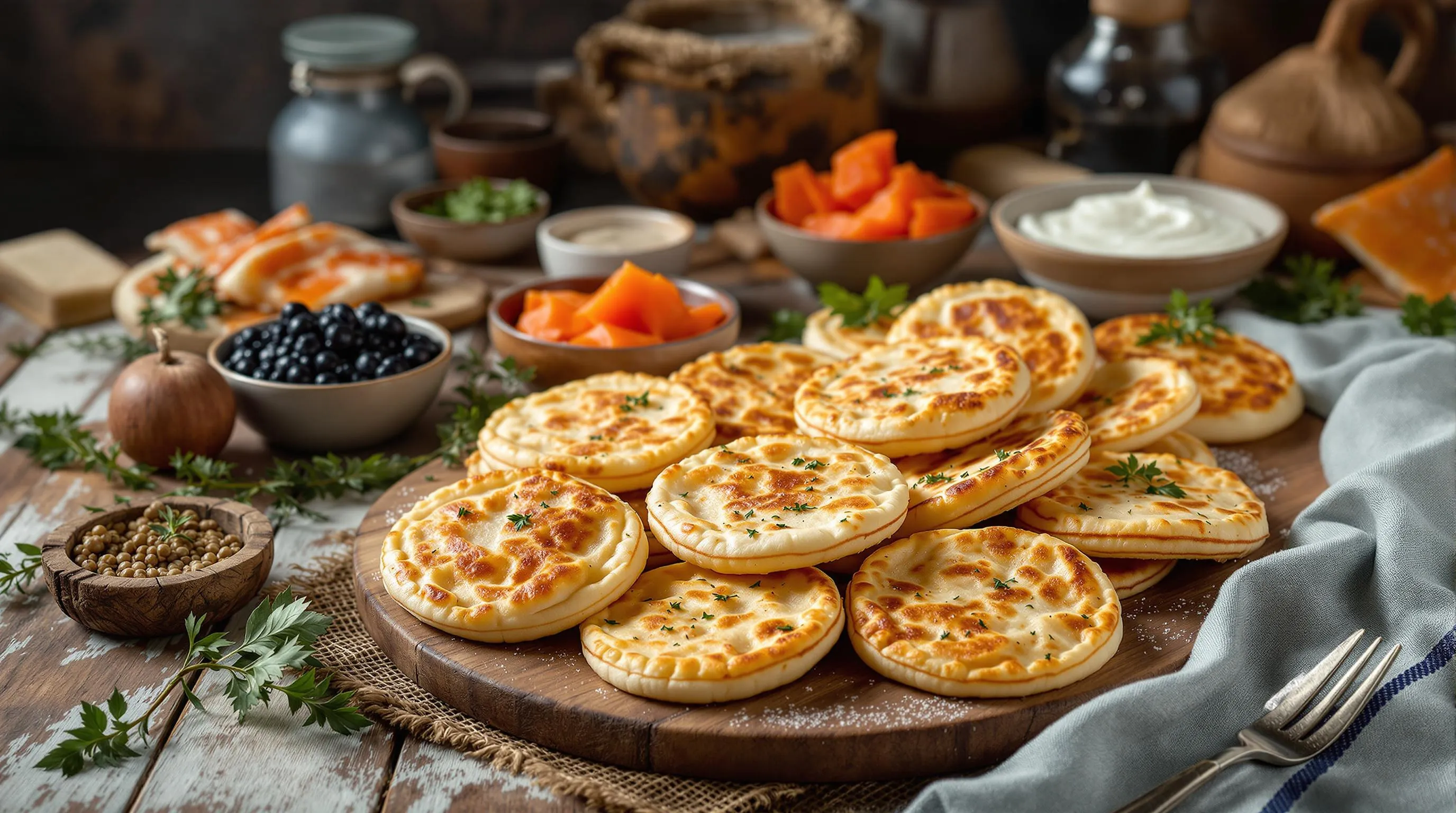
Blini have graced Russian tables for over a thousand years dating back to pre-Christian Slavic culture. These circular pancakes originally symbolized the sun and were integral to pagan spring rituals celebrating the end of winter. Ancient Slavs believed that by consuming these round golden discs they could harness the sun’s power and ensure good harvests.
When Christianity spread throughout Russia in the 10th century blini remained culturally important but evolved in their symbolic meaning. Orthodox Christianity incorporated these beloved pancakes into religious observances particularly during Maslenitsa the week-long celebration preceding Lent. This festival became known as “Butter Week” or “Pancake Week” with blini at its center representing the sun’s return after the long Russian winter.
Medieval Russian cookbooks reveal that early blini were made exclusively with buckwheat flour giving them a distinctive earthy flavor and darker appearance than modern varieties. These traditional crepes were prepared in Russian ovens called “pech” which provided the perfect environment for their characteristic rise and texture. Wealthy households often employed specialized blini-makers called “blinchiki” who perfected the art of creating perfectly thin yet fluffy pancakes.
Peter the Great’s westernization efforts in the 18th century introduced European culinary influences to Russian cuisine including variations in blini preparation. Wheat flour began supplementing or replacing buckwheat creating lighter-colored and milder-tasting blini. The 19th century marked the golden age of Russian cuisine when blini recipes were refined and codified in influential cookbooks like Elena Molokhovets’ “A Gift to Young Housewives” published in 1861.
By the late 19th century blini had become firmly established as both everyday fare and ceremonial food. Imperial Russian aristocracy served elaborately garnished blini topped with caviar sour cream and smoked fish at lavish banquets. Meanwhile in rural homes these pancakes remained a staple nourishment especially during winter months when fresh ingredients were scarce.
Soviet era culinary standardization introduced simplified blini recipes that used more accessible ingredients while maintaining traditional cooking techniques. Even though food shortages and cultural shifts blini persisted as a beloved dish appearing in state-approved cookbooks and remaining central to Maslenitsa celebrations even during periods when religious observances were discouraged.
Today’s Russian blini represent centuries of culinary evolution while maintaining their essential character. Modern variations include quick-rise batters and non-traditional fillings but the fundamental connection to Russian cultural identity remains unchanged. Food historians note that few Russian dishes have maintained such continuity across dramatic political and social changes demonstrating blini’s deep roots in the national consciousness.
Russian emigrants carried their blini traditions worldwide establishing these crepes as perhaps the most internationally recognized Russian food. What began as a pagan sun symbol has endured as Russia’s culinary ambassador connecting modern Russians to their ancestors through the simple pleasure of a perfectly made pancake.
Blini vs. Regular Crepes: The Differences
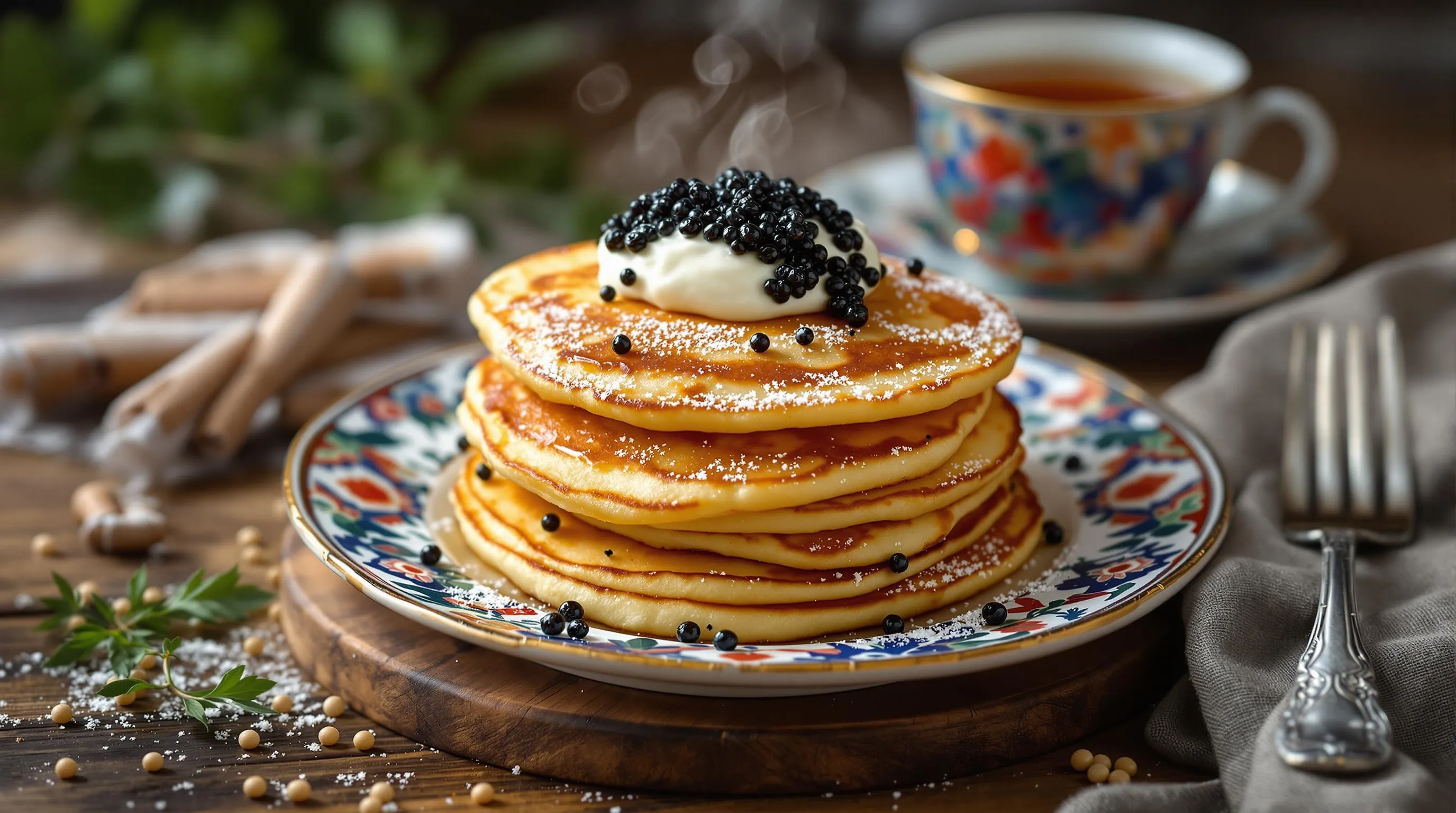
While blini and French crepes may appear similar at first peek both being thin pancakes they possess distinct characteristics that set them apart. Understanding these differences helps appreciate the unique qualities of Russian blini.
Blini feature a yeasted batter which creates their signature airy texture and slightly tangy flavor profile. Regular French crepes typically use a non-fermented batter resulting in a denser consistency. The fermentation process gives blini a more complex taste that develops over several hours.
The flour composition differs significantly between these two pancake varieties. Traditional Russian blini incorporate buckwheat flour either exclusively or mixed with wheat flour. This ingredient imparts a distinctive nutty flavor and darker color. French crepes generally rely on all-purpose flour producing a more neutral taste canvas for toppings.
Thickness represents another notable distinction between these pancake styles. Blini tend to be slightly thicker and spongier than their French counterparts. The active yeast in blini batter creates tiny air pockets during cooking which makes them fluffier and more substantial.
Serving traditions vary considerably between cultures. Russians traditionally pair blini with exact accompaniments like smetana (sour cream) caviar smoked salmon or sweetened condensed milk. French crepes frequently feature sweet fillings such as Nutella fruit preserves or simple sugar with lemon juice though savory versions exist as well.
The cooking technique also differs subtly. Blini are typically cooked on only one side or very briefly on the second side. French crepes are usually flipped and cooked thoroughly on both sides. This cooking method influences the final texture and appearance of each pancake variety.
Symbolism and cultural significance further distinguish these similar dishes. Blini hold deep ceremonial importance in Russian traditions especially during Maslenitsa celebrations. French crepes while beloved don’t carry the same level of ritual significance in their culture of origin.
Conclusion
Blini aren’t just delicious Russian pancakes but a meaningful connection to centuries of tradition. With their distinctive yeasted texture and versatility for both sweet and savory toppings these crepes offer something truly special to your culinary repertoire.
Now you’re equipped with everything needed to create authentic blini at home from the perfect batter technique to traditional serving suggestions. Whether you’re celebrating Maslenitsa or simply bringing Russian cuisine to your breakfast table these delightful crepes will transport you to the heart of Russian food culture.
Try making these beloved pancakes yourself and discover why they’ve remained a cherished staple through generations of Russian history. Your homemade blini journey awaits!

